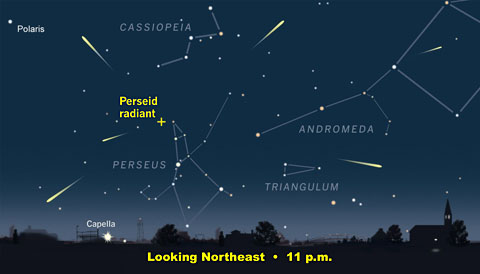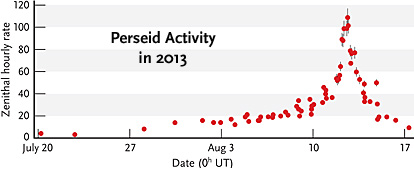This month's usually dependable Perseid meteor shower competes with a nearly full Moon. If you can find a dark viewing location, you might see a bright meteor every few minutes when the shower peaks on the night of August 12–13.

Sky & Telescope diagram
Every three years the Moon displays similar phases at the same dates on the calendar. The rule of thumb is that every phase happens just three days earlier than it did three years ago, on average. You might recall that in 2011 the Perseid meteor shower contended with an almost-full Moon.
Well, it's happening again.
This time the Moon will be two days past full on the peak Perseid night, August 12–13. So it won't be quite as bright as when it's full, but it will illuminate the sky all night, especially from midnight to dawn when the shower's radiant in Perseus is high and the meteors should be most numerous.
But at nightfall the Moon will still be low in the east, and this is when to watch for Earthgrazing Perseids. These are the infrequent, but unusually long and graceful, meteors that you may see when a shower's radiant is low above the horizon.
On their peak night, the Perseids typically produce about 100 meteors per hour when the radiant is near the zenith (directly overhead) and the sky is very dark. The peak rate typically runs for about 12 hours centered on the predicted time, which this year is 0h Universal Time on August 13th (near nightfall on August 12th in North American time zones).
Moonlight will hide faint Perseid meteors, but a nice bright one might show through every few minutes late in the night.

International Meteor Organization
But don't limit yourself to the night of the peak. The shower stays above half of its maximum strength for two days running, and you may see a few Perseids as early the end of July and as late as August 18th, as shown in last year's activity graph at right. The drop-off happens faster than the rise — but the window of Moon-free darkness gets longer on the days following the peak.
Next year's peak Perseid nights will be moonless and ideal.
These meteors occur when bits of debris shed by Comet 109P/Swift-Tuttle slam into Earth's upper atmosphere at a relatively fast 37 miles (60 km) per second. The result is a trail of white-hot plasma (ionized air molecules) along each particle's path, and it's this column of plasma that creates the momentary streaks of light we see in the sky.
Attentive skywatchers realized in the 1830s that the Perseid meteor shower occurs during mid-August each year, though folklore suggests that its annual apparition was known long beforehand. Comet Swift-Tuttle, the shower's source, wasn't discovered until 1862.
Meteor Watching: Fun for All
Meteor watching has become much more of a public thing than it used to be. News media promote the main annual showers in a way that never happened a generation ago. We're proud to have played a part in this; the grand Leonid displays from 1999 to 2002 certainly helped.
But we underestimated how modest a success it takes to get people hooked. Most people know better now that to expect fireworks. Vacationing families with no astronomy experience are often thrilled to see just two or three shooting stars on Perseid night, and many have made it a family tradition.
Remember: you need no equipment — or even knowledge of the constellations — to enjoy the show. Just bring a reclining chair to a dark spot with a wide-open view of the sky, face whatever direction is darkest, lie back, and watch the stars overhead.
Get great tips for watching and studying meteors with Sky & Telescope's ebook, Shooting Stars. It's a free download!
Also: How to photograph a meteor shower (hint: planning, patience, and luck).
 4
4









Comments
Anthony Barreiro
August 5, 2014 at 2:17 pm
This past Saturday night August 2, 2014 the San Francisco Amateur Astronomers held a star party on top of Mount Tamalpais. We had good observing conditions and saw several very bright, long-lasting meteors that left persistent trails. One seemed to be a sporadic meteor, and five looked like Perseids. The meteors were a nice surprise addition to an already lovely night.
You must be logged in to post a comment.
Bob-Kacvinsky
August 9, 2014 at 9:25 am
During the last week of July at the Nebraska Star Party (NSP) near Valentine, Nebraska we experienced 4-5 meteors an hour with several radiating from the NE skyline. Over the 6 nights there were 3 with excellent clear observing and 3 partially clear nights. This was the most meteors I have seen during the past 10 NSP. There were 3-6 each night that created an audible response from the approximately 250 attending the week long event. Cool show.
You must be logged in to post a comment.
August 12, 2014 at 11:29 am
On August 12 at 4 am in Santa Barbara I saw a meteor and shortly after I saw an object with a tint of red in the NE sky moving steadily toward the east and then disappearing. Could this have been a satellite or just an airplane?
You must be logged in to post a comment.
Anthony Barreiro
August 12, 2014 at 2:33 pm
Csaw, yes it could have been a satellite or an airplane. There are a lot of satellites orbiting the Earth, and the hours of dusk and dawn are the best time to see them, when a satellite is in bright sunlight and silhouetted against the still dark sky. The easiest way to distinguish between satellites and airplanes is that airplanes have blinking lights on them while satellites tend to shine steadily, or to wax and wane in brightness more slowly than a blinking airplane light.
By the way, while looking at the Moon around 2230 PDT last night I saw a very bright, slow Perseid meteor that left a wobbly smoke trail through the atmosphere. Very dramatic!
You must be logged in to post a comment.
You must be logged in to post a comment.